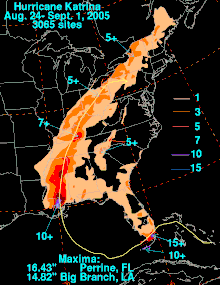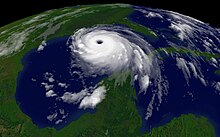Effects of Hurricane Katrina in Florida
Florida Panhandle | |
Part of the 2005 Atlantic hurricane season |
The effects of
After emerging from the state, Katrina intensified into one of the
Background

Hurricane Katrina developed as Tropical Depression Twelve over the
In the preceding 2004 season, Florida was affected by four hurricanes, including hurricanes Frances and Jeanne which hit Martin County and caused billions in damage.[4]
Preparations

About nine hours after the system developed on August 24, the
On August 25, Florida's Emergency Operations Center was activated in Tallahassee to monitor the progress of the hurricane.
While Katrina was intensifying as a major hurricane on August 28, the NHC issued a tropical storm warning and hurricane watch from the Alabama border to Destin along the panhandle. The warning was later extended to Indian Pass.[1] Officials issued a mandatory evacuation for portions of Walton, Gulf, Franklin, and Wakulla counties.[10]
Impact
Overall, Hurricane Katrina killed 14 people in the state, of which 6 were directly related to the storm.[1] Six of the indirect deaths were in South Florida, of which three were from carbon monoxide poisoning caused by generators, one was due to a vehicle accident, one occurred during debris cleanup, and one was associated with a lack of electricity. At least five people were injured due to carbon monoxide poisoning. Overall damage totaled $623 million (2005 USD).[10]
Miami area

While moving across Florida, Katrina had an asymmetric area of thunderstorms, which placed the strongest winds and rainfall over Miami-Dade County.
The heavy rainfall flooded neighborhoods in the area,[1] damaging over 100 houses.[10] The storm left about 1.4 million people without power in Palm Beach, Broward, and Miami-Dade counties.[9] In Broward County north of Katrina's first landfall, the hurricane dropped light rainfall, ranging from 2 to 4 in (51 to 102 mm).[1] Downed trees killed three people in the county.[1] Train and bus service was disrupted in the Miami area.[8] Property damage was estimated at $100 million.[10] Widespread flooding affected crop nurseries and greenhouses,[12] and crop damage totaled $423 million. Three people drowned in Miami-Dade County, two of whom on boats.[10]
Florida Keys and Monroe County
Katrina weakened into a tropical storm while moving across
Elsewhere in Florida
Light rains and winds spread into the Melbourne National Weather Service region. Kennedy Space Center reported wind gusts to 46 mph (74 km/h), although there was no damage or erosion in the area.[14] In southwestern Florida, the storm produced a storm surge of 1.13 ft (0.34 m) in St. Petersburg.[1] In the central portion of the state, some areas for pasture were flooded due to outer rainbands.[12]
Florida panhandle

After striking southeastern Louisiana, Hurricane Katrina made its final landfall in Mississippi, during which it produced a storm surge of about 5.37 ft (1.64 m) in
The winds caused damage to some trees and structures and there was some minor flooding in the panhandle. There were two indirect fatalities from Katrina in Walton County as a result of a traffic accident.[1] Along the Florida panhandle, 77,000 customers lost power.[16] Damage along the panhandle was estimated at $100 million.[10]

Aftermath
On August 28, or about three days after Katrina struck the state, President George W. Bush declared a disaster area for Miami-Dade and Broward counties, which allocated federal funding for debris removal and other emergency services.[17] Three days later, Monroe County was also declared a disaster area, and on the same day the three counties were designated to receive funding for public assistance; this included aid to repair roads and bridges, water control facilities, public buildings, and recreation areas. The declaration was determined after the Federal Emergency Management Agency (FEMA) sent 20 State Emergency Response Teams to determine the extent of damage.[18] After Hurricane Katrina struck the Gulf Coast, President Bush declared a disaster area for seven counties along the Florida panhandle on September 6; the counties were Bay, Escambia, Franklin, Gulf, Okaloosa, Santa Rosa, and Walton. In addition, Collier County in southwestern Florida was added to the list of disaster areas.[19]
In the two months after Katrina struck south Florida, Hurricane Rita brushed the region in late September with tropical storm-force winds and flooding rains.[20] In late October, Hurricane Wilma struck southwestern Florida as a major hurricane, affecting the Miami area with hurricane-force winds that left 98% of south Florida without power.[21] Including Hurricane Dennis in July, FEMA provided $1 billion in public assistance to Florida residents in association with the four hurricanes in 2005.[22]
References
- ^ a b c d e f g h i j k l m n o p q r s t Richard Knabb; Jamie Rhome; Daniel Brown (2005-12-20). Hurricane Katrina Tropical Cyclone Report (PDF) (Report). National Hurricane Center. Retrieved 2012-04-07.
- ^ Stacy Stewart (2005-08-25). Tropical Storm Katrina Discussion Eight (Report). National Hurricane Center. Retrieved 2012-04-07.
- ^ Stacy Stewart (2005-08-25). Hurricane Katrina Discussion Nine (Report). National Hurricane Center. Retrieved 2012-04-07.
- ^ Lixion Avila; et al. (2004-12-01). Monthly Tropical Weather Summary... Corrected (Report). National Hurricane Center. Retrieved 2012-04-07.
- ^ Officials Urge Preparedness As Katrina Intensifies (Report). Federal Emergency Management Agency. 2005-08-25. Archived from the original on 2010-06-08. Retrieved 2012-04-11.
- ^ "Hurricane Katrina drenches Florida". Television New Zealand. Reuters. 2005-08-26. Archived from the original on 2013-12-21. Retrieved 2012-04-10.
- ^ Shadi Rahimi (2005-08-25). "Tropical Storm Becomes a Hurricane as it Nears Florida". The New York Times. Retrieved 2012-04-10.
- ^ a b "Reeling from hurricane, Florida braces for 2nd hit". The New York Times. Agence France-Presse. 2005-08-27. Retrieved 2012-04-10.
- ^ a b c d Joseph B. Treaster; Shadi Rahimi (2005-08-26). "Hurricane Moves Over Gulf After Soaking Southern Florida". The New York Times. Retrieved 2012-04-10.
- ^ a b c d e f g h i j k l Storm Data and Unusual Weather Phenomena with Late Reports and Corrections (PDF) (Report). Vol. 47. National Climatic Data Center. August 2005. Retrieved 2012-04-10.
- Hydrometeorological Prediction Center. Retrieved 2012-04-09.
- ^ a b Weekly Weather and Crop Bulletin (PDF) (Report). Vol. 92. United States Department of Agriculture. 2005-08-30. p. 17. Archived from the original (PDF) on 2012-06-18. Retrieved 2012-04-11.
- ^ Kennard B. Kasper (2011). A Climatology of Tropical Cyclone-Induced Tornadoes in the Florida Keys (PDF). 24th Conference on Weather Analysis and Forecasting. Seattle, Washington: Key West National Weather Service. Retrieved 2012-04-10.
- ^ Spratt, Turner, and Cannon (2005-08-30). Post Tropical Cyclone Report... Hurricane Katrina (Report). Melbourne, Florida National Weather Service. Retrieved 2012-04-10.
{{cite report}}: CS1 maint: multiple names: authors list (link) - ^ Photograph by Marvin Nauman taken on 08/31/2005 in Florida (Report). Federal Emergency Management Agency. Retrieved 2012-04-11.
- ^ "Katrina at a Glance" (PDF). Mobile Register. Associated Press. 2005-08-31. p. 4A. Archived from the original (PDF) on 2008-10-01.
- ^ President Declares Major Disaster For Florida (Report). Federal Emergency Management Agency. 2005-08-28. Archived from the original on 2010-06-06. Retrieved 2012-04-11.
- ^ FEMA Expands Public Assistance For South Florida Counties Affected By Katrina (Report). Federal Emergency Management Agency. 2005-08-31. Archived from the original on 2010-06-08. Retrieved 2012-04-11.
- ^ Public Assistance Expanded To Include Eight More Florida Counties (Report). Federal Emergency Management Agency. 2005-08-28. Archived from the original on 2010-06-06. Retrieved 2012-04-11.
- ^ Richard Knabb; Daniel Brown; Jamie Rhome (2006-03-17). Hurricane Rita Tropical Cyclone Report (PDF) (Report). National Hurricane Center. Retrieved 2012-04-11.
- ^ Richard Pasch; Eric Blake; Hugh Cobb III; David Roberts (2006-01-12). Hurricane Wilma Tropical Cyclone Report (PDF) (Report). National Hurricane Center. Retrieved 2012-04-11.
- ^ $1 Billion In Public Assistance For Florida 2005 Recovery (Report). Federal Emergency Management Agency. 2006-04-16. Archived from the original on 2012-06-01. Retrieved 2012-04-11.
| Hurricane Katrina |
|---|
 |
| 2005 Atlantic hurricane season |
| General |
|
| Impact |
| Relief |
| Analysis |
| External links |
|
